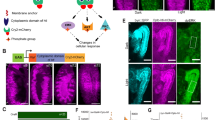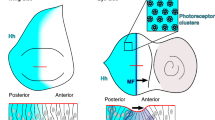Abstract
GENETIC studies show that intercellular signalling is involved in key steps in Drosophila melanogaster development, but it has not previously been possible to investigate these processes in simplified in vitro systems. Analysis of engrailed (en) and wingless (wg) and other segment polarity genes suggests that two or more intercellular signalling processes may be involved in intrasegmental patterning1–3. Expression of en and wg begins about three hours after egg laying, in adjacent rows of cells in the posterior half of each segmental primordium4–7. In wg− embryos and in conditional mutants in which wg function is inactivated during a critical period between three and five hours after egg laying, early en expression begins normally but then disappears within several hours4,8–10. The wg gene encodes a protein highly similar to the product of the mouse Wnt-1 proto-oncogene, a secreted glycoprotein11,12; wg protein is proposed to function as an extracellular signal, maintaining en expression and activating other molecular and morphogenetic processes in nearby cells4,8,9,13. Several lines of evidence support the model, including the secretion of wg protein in the embryo7,14, genetic mosaic experiments15–17 and cell lineage studies18. We tested this model using purified embryonic cells isolated by whole animal cell sorting19, and validated three key predictions: (1) when en-expressing cells from early embryos are grown alone in culture, they rapidly and selectively lose en expression; (2) purified wg-expressing cells provide a locally active signal that prevents this loss; (3) heterologous cells engineered to express wg also show signalling activity, indicating that wg protein alone, or in conjunction with more generally expressed factors, is the signal.
This is a preview of subscription content, access via your institution
Access options
Subscribe to this journal
Receive 51 print issues and online access
$199.00 per year
only $3.90 per issue
Buy this article
- Purchase on Springer Link
- Instant access to full article PDF
Prices may be subject to local taxes which are calculated during checkout
Similar content being viewed by others
References
Ingham, P. W. Curr. Opin. Genet. Dev. 1, 261–267 (1991).
DiNardo, S. & Heemskerk, J. Sem. Cell Biol. 1, 173–183 (1990).
Ingham, P. W. & Martinez Arias, A. Cell 68, 221–235 (1992).
Martinez Arias, A., Baker, N. E. & Ingham, P. W. Development 103, 157–170 (1988).
Kornberg, T., Siden, I., O'Farrell, P. & Simon, M. Cell 40, 45–53 (1985).
Baker, N. E. EMBO J. 6, 1765–1773 (1987).
van den Heuvel, M., Nusse, R., Johnstone, P. & Lawrence, P. A. Cell 59, 739–749 (1989).
DiNardo, S., Sher, E., Heemskerk-Jongens, J., Kassis, J. A. & O'Farrell, P. H. Nature 332, 604–609 (1988).
Bejsovec, A. & Martinez Arias, A. Development 113, 471–485 (1991).
Heemskerk, J., DiNardo, S., Kostriken, R. & O'Farrell, p. Nature 352, 404–410 (1991).
Rijsewijk, F. et al. Cell 50, 649–657 (1987).
Nusse, R. & Varmus, H. E. Cell 69, 1073–1087 (1992).
Riggleman, R., Schedl, P. & Wieschaus, E. Cell 63, 549–560 (1990).
Gonzalez, F., Swales, L., Bejsovec, A., Skaer, H. & Martinez Arias, A. Mech. Dev. 35, 43–54 (1991).
Morata, G. & Lawrence, P. A. Devl Biol. 56, 227–240 (1977).
Baker, N. E. Devl Biol. 125, 96–108 (1988).
Wieschaus, E. & Riggleman, R. Cell 49, 177–184 (1987).
Vincent, J. P. & O'Farrell, P. Cell 68, 923–931 (1992).
Krasnow, M. A., Cumberledge, S., Manning, G., Herzenberg, L. A. & Nolan, G. P. Science 251, 81–85 (1991).
Schneider, I. J. Embryol. exp. Morph. 27, 353–365 (1972).
Hama, C., Ali, Z. & Kornberg, T. B. Genes Dev. 4, 1079–1093 (1990).
Author information
Authors and Affiliations
Rights and permissions
About this article
Cite this article
Cumberledge, S., Krasnow, M. Intercellular signalling in Drosophila segment formation reconstructed in vitro. Nature 363, 549–552 (1993). https://doi.org/10.1038/363549a0
Received:
Accepted:
Issue Date:
DOI: https://doi.org/10.1038/363549a0
This article is cited by
-
Travelling and splitting of a wave of hedgehog expression involved in spider-head segmentation
Nature Communications (2011)
-
Area-based analyzing technique at cell array experiment using neuronal cell line
NanoBiotechnology (2006)
-
Chimeric Wnt proteins define the amino-terminus of Wnt-1 as a transformation-specific determinant
Oncogene (1999)
-
Biological activity of soluble wingless protein in cultured Drosophila imaginal disc cells
Nature (1994)
-
Both upstream and intragenic sequences of the human neurofilament light gene direct expression oflacZ in neurons of transgenic mouse embryos
Journal of Molecular Neuroscience (1994)
Comments
By submitting a comment you agree to abide by our Terms and Community Guidelines. If you find something abusive or that does not comply with our terms or guidelines please flag it as inappropriate.



